Here are the directions to our little felt Easter bunnies....
First: using the pattern provided at the last meeting, cut out the following: 2 body portions in felt 2 ears in felt 1 head gusset in felt or flannel 1 underbody in flannel 2 inner ear pieces in flannel (just use the ear pattern and size down a smidge)
You are ready to begin sewing. We will be using the overcast stitch for all portions. In order to prevent fraying of the flannel you will have to overcast forward and backward... creating a crisscross pattern. I have tried to get a close up picture of what this will look like. With the embroidery thread of your choosing, begin sewing the 2 body pieces together.
You will start at the top of the head, just behind where you plan to place the ears. You will continue down the backside of the body and stop just before the point you plan to place the tail. Now, overcast all the way back up the bunnies back and end where you began.

You are now ready to sew the gusset. This is the small piece that is placed in the forehead of the bunny. Begin by sewing one side of the gusset from the top of the forehead to the bottom.
Once at the bottom, neatly shape body portion of the felt to the gusset and sew from bottom to top on the other side. You will need to sew back around the other direction. This time around, stop at the bottom and
sew 5 small stitches to create the nose. Continue
to sew back up to the top.
Next, grab the underbody of the bunny. This will be the trickiest part of the project. Neatly match up the point of the underside, so that it lines up just underneath the nose of the bunny. You may need to trim the point small amount, so that underbody arms line up with the felt body arms. Be careful not to overtrim. The match up may not look precise, but as soon as you begin sewing, you will shape the felt to the underbody... matching and sewing as you go. Start at the point of the underbody and begin to sew down one side of the bunny. Be sure and leave a few stitches at the back end of the bunny for stuffing. Sew back the other way in a crisscross pattern.
Now sew the other side of the underbody to the felt body. Begin at the point of the underbody again carefully lining the underbody up with the felt as you sew.
Leave a few stitches at the end for stuffing and sew all the way back in a crisscross pattern. You should now be ready to stuff. All of the pieces of the body are now in place. Use the back end of a crochet hook or a knitting needle to help push the stuffing into the head and arms. Pack the stuffing firmly. Once you Bunny is stuffed, you will sew up the bottom. Place your pom-pom over the last few bulky stitches on the bunnies behind, and sew the pom-pom into place.

You, now have only to sew the ears. Using the overcast stitch, sew the flannel inner ear onto the flannel ear bits. Position the bunny ears so that they are at the crest of the bunny's head and sew into place. Be sure to sew them on securely.

With the embroidery thread of your choosing you may use a few stitches for the bunnies eyes. Finish of the bunny by tying a nice bow around the bunny's neck... and you bunny is ready to placed in your crochet basket!!



















































